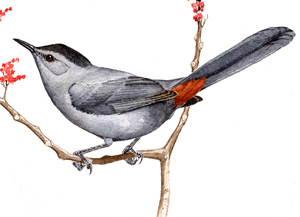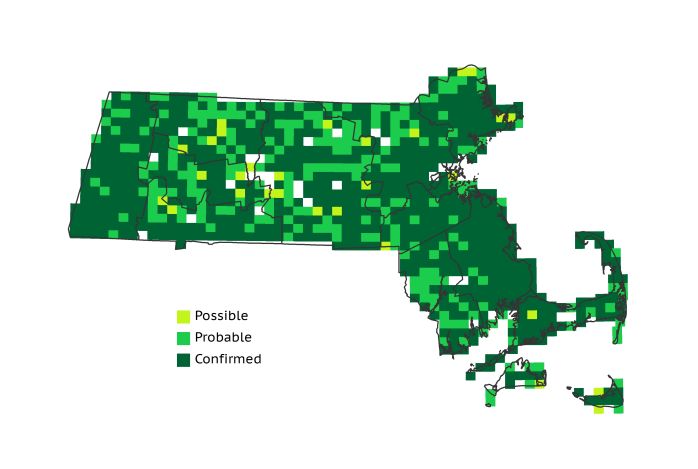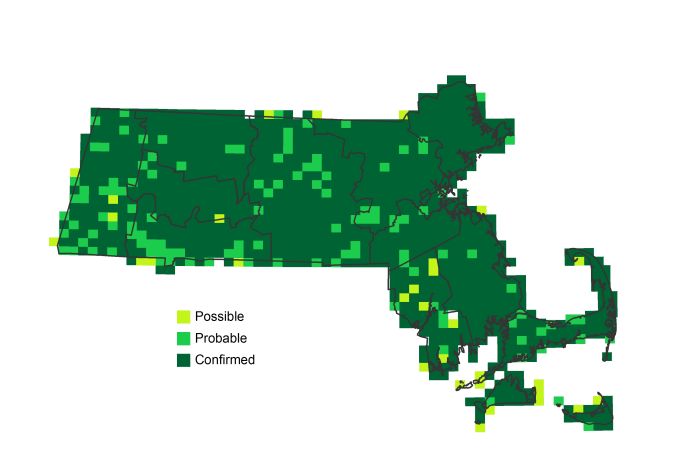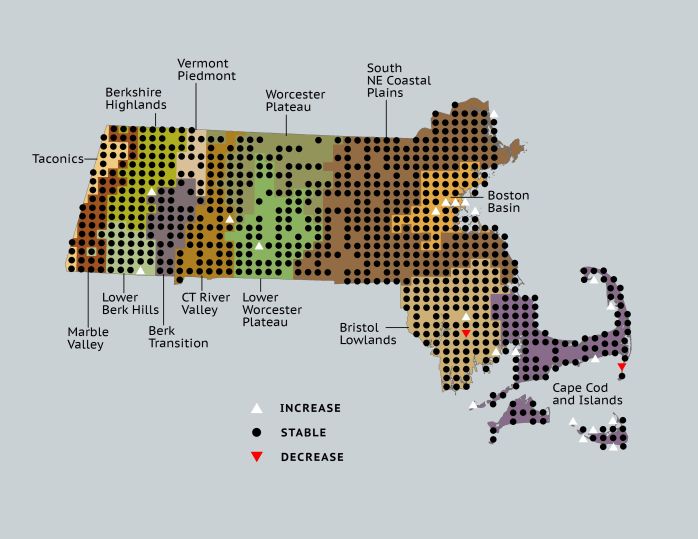Breeding Bird Atlases (BBA)
Find a Bird
Gray Catbird
Dumetella carolinensis

Nearly ubiquitous and stable

“’Tearing up the pea patch’ meant going on a rampage; ‘sitting in the catbird seat’ means sitting pretty, like a batter with three balls and no strikes on him.”—James Thurber, “The Catbird Seat”
While many of our songbirds will sing from the most prominent perch available, the Gray Catbird prefers a different tactic. The loud, squeaky song of the catbird is most often heard emanating from the depths of a hedge or thorny tangle. Singing from this position of security – his "catbird seat" – the male catbird proves that it is just as vociferous as the rest of the mimics, a family that also includes the Northern Mockingbird and Brown Thrasher. Occasionally, Gray Catbirds will interrupt their singing to give the harsh mewing call, strikingly similar to that of a domestic cat, a habit that gives them their common name.
Historic Status
Nineteenth-century Massachusetts residents disliked catbirds. “The country boy pursues it with stones and imprecations,” said Edward Howe Forbush, “and even some of its neighbors among the birds manifest animosity,” (Forbush 1929). Known as garden thieves, the birds were “strangely persecuted” according to William Peabody (Peabody 1839), despite their beneficial nature to the farmer. Apparently nonplussed, Gray Catbirds not only bred in Massachusetts regularly during the 1800s, but in about 1877 they began wintering here as well (Howe & Allen 1901). They mewed their way into the twentieth century in the Bay State, dodging stones and buckshot, their numbers steadily increasing.
Atlas 1 Distribution
Birds that thrive in woodland edges, overgrown lots, and suburban areas were enjoying boom times during Atlas 1, as the Gray Catbird’s distribution clearly demonstrated with its overall block occupancy of 94%. The species was missing from 1 or 2 blocks at most in any region from the Connecticut River Valley westward. Less-than-ideal Atlas coverage in the Worcester Plateau regions is likely to blame for the species’ apparent absence from a dozen or so blocks in that area. Catbirds were quite widespread throughout the rest of the state. In fact, Gray Catbirds were absent only from the most heavily urbanized parts of the Boston Basin and a few small areas in the Bristol/Narragansett Lowlands and the Cape and Islands.
Atlas 2 Distribution and Change
Though somewhat shy and not often seen by casual observers, Gray Catbirds nonetheless proliferated across every thicket and hedge in the Commonwealth. By Atlas 2, they’d made small gains and were found in 98% of the blocks surveyed, and were the second most widely distributed bird just slightly behind the Song Sparrow. Catbirds were truly ubiquitous in every region west of the Coastal Plains, and were absent from only a handful of blocks at most in the eastern regions. They clearly occupy The Catbird Seat.
Atlas 1 Map

Atlas 2 Map

Atlas Change Map

Ecoregion Data
Atlas 1 | Atlas 2 | Change | ||||||
Ecoregion | # Blocks | % Blocks | % of Range | # Blocks | % Blocks | % of Range | Change in # Blocks | Change in % Blocks |
Taconic Mountains | 16 | 100.0 | 1.8 | 23 | 92.0 | 2.3 | 0 | 0.0 |
Marble Valleys/Housatonic Valley | 39 | 100.0 | 4.3 | 39 | 100.0 | 3.8 | 0 | 0.0 |
Berkshire Highlands | 54 | 98.2 | 5.9 | 55 | 100.0 | 5.4 | 1 | 1.9 |
Lower Berkshire Hills | 27 | 96.4 | 3.0 | 30 | 96.8 | 3.0 | 1 | 3.7 |
Vermont Piedmont | 16 | 94.1 | 1.8 | 17 | 100.0 | 1.7 | 0 | 0.0 |
Berkshire Transition | 38 | 100.0 | 4.2 | 40 | 100.0 | 3.9 | 0 | 0.0 |
Connecticut River Valley | 54 | 96.4 | 5.9 | 64 | 98.5 | 6.3 | 1 | 2.1 |
Worcester Plateau | 75 | 96.2 | 8.2 | 86 | 97.7 | 8.5 | 0 | 0.0 |
Lower Worcester Plateau | 66 | 89.2 | 7.2 | 80 | 100.0 | 7.9 | 1 | 1.9 |
S. New England Coastal Plains and Hills | 265 | 98.1 | 29.0 | 280 | 98.9 | 27.6 | 1 | 0.4 |
Boston Basin | 48 | 85.7 | 5.3 | 54 | 96.4 | 5.3 | 5 | 9.1 |
Bristol and Narragansett Lowlands | 101 | 95.3 | 11.1 | 111 | 97.4 | 10.9 | 1 | 1.0 |
Cape Cod and Islands | 114 | 83.8 | 12.5 | 136 | 94.4 | 13.4 | 9 | 7.5 |
Statewide Total | 913 | 94.2 | 100.0 | 1015 | 97.9 | 100.0 | 20 | 2.4 |
Notes
The Gray Catbird shows a significant increasing Breeding Bird Survey (BBS) trend in the New England/Mid-Atlantic Region but shows a significant decreasing BBS trend in the Eastern US overall.



